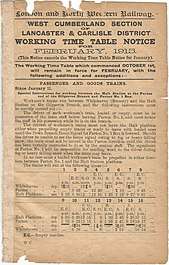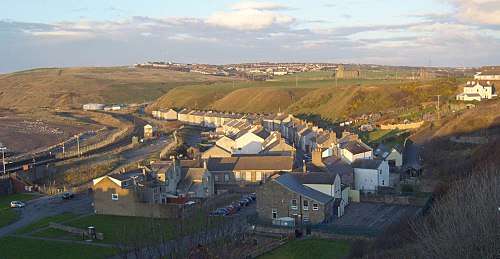Parton Halt railway station
Parton Halt railway station was opened by the LNWR and FR Joint Railway ("The Joint Line") in January 1915 and closed by the LMSR fourteen years later in 1929.
| Parton Halt | |
|---|---|
 The LNWR Working Time Table for the halt, February 1915 | |
| Location | |
| Place | Parton, north of Whitehaven |
| Area | Copeland |
| Coordinates | 54.5747°N 3.5781°W |
| Grid reference | NX980210 |
| Operations | |
| Original company | LNWR & Furness Joint Railway |
| Post-grouping | London, Midland and Scottish Railway |
| Platforms | 1 |
| History | |
| 1 January 1915 | Opened to workmen's trains |
| 1 April 1929 | Closed[1][2][3] |
| 2 November 1929 | Demolished[4] |
| Disused railway stations in the United Kingdom | |
| Closed railway stations in Britain A B C D–F G H–J K–L M–O P–R S T–V W–Z | |

Lowca Light Railway and Gilgarran Branch | |||||||||||||||||||||||||||||||||||||||||||||||||||||||||||||||||||||||||||||||||||||||||||||||||||||||||||||||||||||||||||||||||||||||||||||||||||||||||||||||||||||||||||||||||||||||||||||||||||||||||||||||||||||||||||||||||||||||||||
|---|---|---|---|---|---|---|---|---|---|---|---|---|---|---|---|---|---|---|---|---|---|---|---|---|---|---|---|---|---|---|---|---|---|---|---|---|---|---|---|---|---|---|---|---|---|---|---|---|---|---|---|---|---|---|---|---|---|---|---|---|---|---|---|---|---|---|---|---|---|---|---|---|---|---|---|---|---|---|---|---|---|---|---|---|---|---|---|---|---|---|---|---|---|---|---|---|---|---|---|---|---|---|---|---|---|---|---|---|---|---|---|---|---|---|---|---|---|---|---|---|---|---|---|---|---|---|---|---|---|---|---|---|---|---|---|---|---|---|---|---|---|---|---|---|---|---|---|---|---|---|---|---|---|---|---|---|---|---|---|---|---|---|---|---|---|---|---|---|---|---|---|---|---|---|---|---|---|---|---|---|---|---|---|---|---|---|---|---|---|---|---|---|---|---|---|---|---|---|---|---|---|---|---|---|---|---|---|---|---|---|---|---|---|---|---|---|---|---|---|---|---|---|---|---|---|---|---|---|---|---|---|---|---|---|---|
| |||||||||||||||||||||||||||||||||||||||||||||||||||||||||||||||||||||||||||||||||||||||||||||||||||||||||||||||||||||||||||||||||||||||||||||||||||||||||||||||||||||||||||||||||||||||||||||||||||||||||||||||||||||||||||||||||||||||||||
| |||||||||||||||||||||||||||||||||||||||||||||||||||||||||||||||||||||||||||||||||||||||||||||||||||||||||||||||||||||||||||||||||||||||||||||||||||||||||||||||||||||||||||||||||||||||||||||||||||||||||||||||||||||||||||||||||||||||||||
1972 | |||||||||||||||||||||||||||||||||||||||||||||||||||||||||||||||||||||||||||||||||||||||||||||||||||||||||||||||||||||||||||||||||||||||||||||||||||||||||||||||||||||||||||||||||||||||||||||||||||||||||||||||||||||||||||||||||||||||||||
| |||||||||||||||||||||||||||||||||||||||||||||||||||||||||||||||||||||||||||||||||||||||||||||||||||||||||||||||||||||||||||||||||||||||||||||||||||||||||||||||||||||||||||||||||||||||||||||||||||||||||||||||||||||||||||||||||||||||||||
| |||||||||||||||||||||||||||||||||||||||||||||||||||||||||||||||||||||||||||||||||||||||||||||||||||||||||||||||||||||||||||||||||||||||||||||||||||||||||||||||||||||||||||||||||||||||||||||||||||||||||||||||||||||||||||||||||||||||||||
The halt never appeared on any public timetable, as it was provided to enable workmen to get from Whitehaven to the isolated colliery, coke ovens and bi-products plant on the hilltop at Lowca. The halt was at the foot of steep tracks up to these workplaces.
Location
The line past the halt is clearly shown on standard railway maps,[5][6] but the halt eludes them all; however, it is shown on contemporary OS maps.[7][8] It is not to be confused with Parton which in 2015 remained on the Cumbrian Coast Line 25 chains (0.50 km) to the south of the site of the halt.
Further research is needed to establish the physical nature of the halt, such structures in many parts of the country were very rudimentary.
History
The halt was on the WCER's Gilgarran Branch, occasionally referred to as the Gilgarron Branch. The company and the branch were fruits of the rapid industrialisation of West Cumberland in the second half of the nineteenth century.
All lines in the area were primarily aimed at mineral traffic, notably iron ore, coal and limestone, few more so than the Gilgarran Branch. Many iron mines, quarries, collieries and attendant works were situated in inaccessible areas with low populations, making workmen's trains a natural add-on service. Lowca had a workmen's service - and for a shorter period an advertised passenger service - from the north along the clifftops provided by the Lowca Light Railway in conjunction with the Cleator and Workington Junction Railway (CWJR). The service to Parton Halt met the same need from the south.
Services
No Sunday passenger service was provided.
A passenger service from Distington to Whitehaven along the Gilgarran Branch had run from 1881 to 1883, but it was not a success and was withdrawn. A Thursdays and Saturdays only (Market Days) service was run from Distington to Whitehaven, calling or changing at Parton from autumn 1913 (sources disagree whether from October or November) to September 1914,[9] these trains passed the site of the future Parton Halt, but served a different purpose.
The initial service, which started on 11 January 1915, can be seen on the attached Working Time table (WTT) extract. Service times were set to match shift changes at the colliery and associated works. This was a common pattern with such halts across the country.
Goods traffic passed the halt, but did not call.[10] The April 1917 Working Time Table shows three Up mineral trains travelling a mile beyond the halt to No 4 Pit and two travelling beyond to Distington Ironworks, with an extra on Saturdays, all matched by Down trains.
The line past the site of the halt went on to become a late survivor on the West Cumberland scene. The colliery at Lowca wound coal until 1968, feeding the associated works. After it closed coal continued to come from Solway Colliery, Workington until it closed in 1973, at which point the surviving business for the bi-product works and coal washery at Lowca was handled by road. The end products from Lowca were taken away northwards along the clifftops using the surviving parts of the Lowca Light Railway.[11] Incoming coal from Solway Colliery was worked south along the coast line to Parton, where the train reversed 1 mile 11 chains (1.8 km) up the Gilgarron Branch, past the site of the halt to a junction known as "Bain's Siding" where it ran forward up the side of the valley to Lowca, effecting a zig-zag to gain the necessary height.[12][13] Until 1968 at least, coal was also wound at No.4 Pit near Bain's Siding and taken down the branch past the site of the halt.[14]
Rundown and closure
The halt closed in 1929, with buses able to provide a more attractive door-to-workplace gate service. The line past its site closed in May 1973.[15] Nearby sidings were retained for many more years for Civil Engineers, but have since been lifted.[14]
Afterlife
By 2013 most of the trackbed through the halt had been obliterated. Further towards Distington the Gilgarran Branch's route had been recycled as a public cycleway.[16]
| Preceding station | Disused railways | Following station | ||
|---|---|---|---|---|
| Parton Line closed, station open |
LNWR & FR Joint Railway Gilgarran Branch |
Distington Line and station closed |
See also
References
- Butt 1995, p. xxx.
- Croughton, Kidner & Young 1982, p. 111.
- Quick 2009, p. 306.
- Foster 2019, pp. 18-21.
- Jowett 1989, Map 36.
- Smith & Turner 2012, Map 26.
- The halt on a 1927 OS map via National Library of Scotland
- The halt on a 1937 OS map via National Library of Scotland
- Quayle 2007, p. 46.
- Quayle 2007, pp. 79-80.
- McGowan Gradon 2004, p. 53.
- Anderson 2002, p. 309.
- Quayle 2007, p. 45.
- Quayle 2007, p. 80.
- Marshall 1981, p. 163.
- Suggitt 2008, pp. 60-62.
Sources
- Anderson, Paul (April 2002). Hawkins, Chris (ed.). "Dog in the Manger? The Track of the Ironmasters". British Railways Illustrated. Clophill: Irwell Press Ltd. 11 (7). ISSN 0961-8244.CS1 maint: ref=harv (link)
- Butt, R. V. J. (1995). The Directory of Railway Stations: details every public and private passenger station, halt, platform and stopping place, past and present (1st ed.). Sparkford: Patrick Stephens Ltd. ISBN 978-1-85260-508-7. OCLC 60251199.
- Croughton, Godfrey; Kidner, R. W.; Young, Alan (1982). Private and Untimetabled Railway Stations, Halts and Stopping Places. The Oakwood Press. ISBN 978-0-85361-281-0. OCLC 10507501.
- Foster, Richard (February 2019). Peascod, Michael (ed.). "Distington and the Gilgarran Branch Part 5". Cumbrian Railways. Pinner: Cumbrian Railways Association. 13 (1). ISSN 1466-6812.CS1 maint: ref=harv (link)
- Jowett, Alan (March 1989). Jowett's Railway Atlas of Great Britain and Ireland: From Pre-Grouping to the Present Day (1st ed.). Sparkford: Patrick Stephens Ltd. ISBN 978-1-85260-086-0. OCLC 22311137.
- McGowan Gradon, William (2004) [1952]. The Track of the Ironmasters: A History of the Cleator and Workington Junction Railway. Grange-over-Sands: Cumbrian Railways Association. ISBN 978-0-9540232-2-5.CS1 maint: ref=harv (link)
- Marshall, John (1981). Forgotten Railways: North West England. Newton Abbot: David and Charles. ISBN 978-0-7153-8003-1.CS1 maint: ref=harv (link)
- Quayle, Howard (2007). Whitehaven: The Railways and Waggonways of a Unique Cumberland Port. Pinner: Cumbrian Railways Association. ISBN 978-0-9540232-5-6.CS1 maint: ref=harv (link)
- Quick, Michael (2009) [2001]. Railway passenger stations in Great Britain: a chronology (4th ed.). Oxford: Railway and Canal Historical Society. ISBN 978-0-901461-57-5. OCLC 612226077.
- Smith, Paul; Turner, Keith (2012). Railway Atlas Then and Now. Shepperton: Ian Allan Publishing. ISBN 978-0-7110-3695-6.CS1 maint: ref=harv (link)
- Suggitt, Gordon (2008). Lost Railways of Cumbria (Railway Series). Newbury: Countryside Books. ISBN 978-1-84674-107-4.CS1 maint: ref=harv (link)
Further reading
- Atterbury, Paul (2009). Along Lost Lines. Newton Abbot: David & Charles. ISBN 978-0-7153-2706-7.CS1 maint: ref=harv (link)
- Bairstow, Martin (April 1995). Railways In The Lake District. Martin Bairstow. ISBN 978-1-871944-11-2.CS1 maint: ref=harv (link)
- Bowtell, Harold D. (1989). Rails through Lakeland: An Illustrated Journey of the Workington-Cockermouth-Keswick-Penrith Railway 1847-1972. Wyre: Silverlink Publishing Ltd. ISBN 978-0-947971-26-7.CS1 maint: ref=harv (link)
- Bradshaw, George (1985) [July 1922]. Bradshaw's General Railway and Steam Navigation guide for Great Britain and Ireland: A reprint of the July 1922 issue. Newton Abbot: David and Charles. ISBN 978-0-7153-8708-5. OCLC 12500436.
- Conolly, W Philip (1998). British railways pre-grouping atlas and gazetteer (9th impression; 5th ed.). Shepperton: Ian Allan. ISBN 978-0-7110-0320-0. OCLC 221481275.
- Haynes, Jas. A. (April 1920). Cleator & Workington Junction Railway Working Time Table. Central Station, Workington: Cleator and Workington Junction Railway.CS1 maint: ref=harv (link)
- Joy, David (1983). Lake Counties (Regional History of the Railways of Great Britain). Newton Abbot: David and Charles. ISBN 978-0-946537-02-0.CS1 maint: ref=harv (link)
- Western, Robert (2001). The Cockermouth, Keswick and Penrith Railway OL113. Usk: Oakwood Press. ISBN 978-0-85361-564-4.CS1 maint: ref=harv (link)
External links
- Map of the CWJR with photos RAILSCOT
- Map of the WC&ER with photos RAILSCOT
- The station Rail Map Online
- The site of the halt on overlain OS maps surveyed from 1898 National Library of Scotland
- The site of the halt on a 1948 OS Map npe maps
- The line (halt as PARTON) railwaycodes
- "The Joint Lines" including the halt cumberlandarchives.co.uk
- The railways of Cumbria Cumbrian Railways Association
- Photos of Cumbrian railways Cumbrian Railways Association
- The railways of Cumbria Railways_of_Cumbria
- Cumbrian Industrial History Cumbria Industrial History Society
- Furness Railtour using many West Cumberland lines 5 September 1954 sixbellsjunction
- A video tour-de-force of the region's closed lines cumbriafilmarchive
- 1882 RCH Diagram showing the line through the future halt, see page 173 of the pdf google
- Haematite earthminerals
- Coal and iron ore mining in Cleator Moor Haig Pit
- The halt's site near bottom left corner of photo flickr